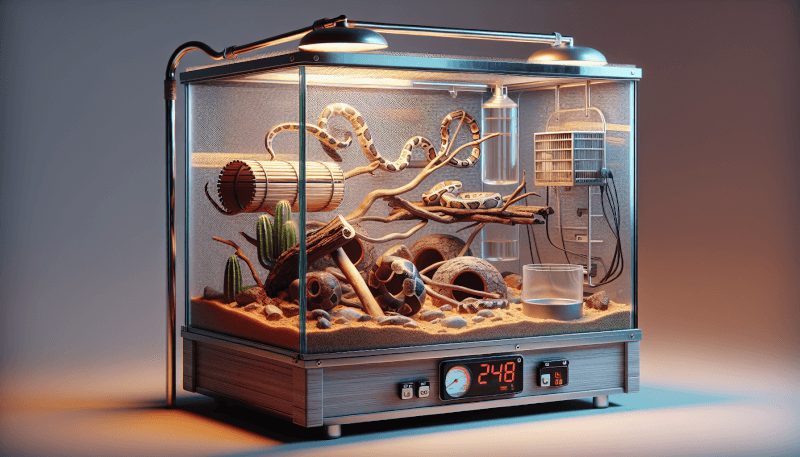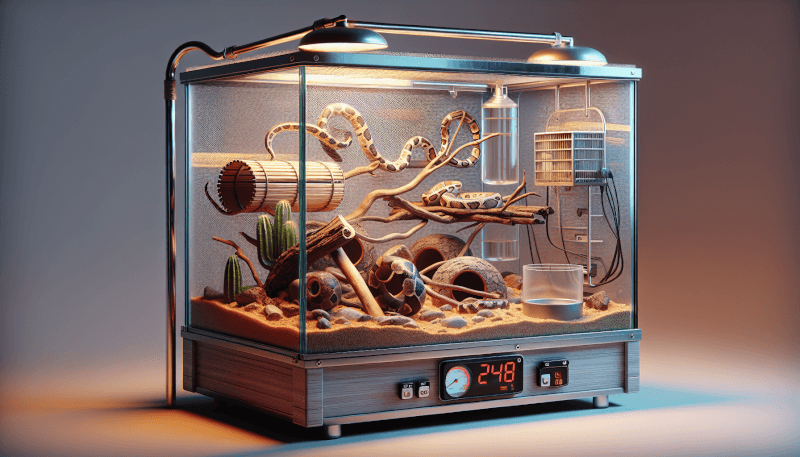Are you a proud owner of a pet snake or considering getting one? As fascinating as these reptiles are, it’s important to know how to properly care for them to ensure their health and well-being. In this article, you will discover valuable tips and tricks on how to prevent and treat common health issues that may arise in pet snakes. From providing the right enclosure conditions to recognizing signs of illness and seeking proper veterinary care, you will be equipped with the knowledge to keep your slithery friend happy and healthy. So, let’s dive into the world of snake care and ensure the well-being of our scaly companions!
Preventive Measures for Pet Snake Health
Importance of Proper Enclosure
Proper enclosure is essential for the overall health and well-being of your pet snake. Snakes need a secure and appropriately sized enclosure that mimics their natural habitat. A suitable enclosure should have enough space for the snake to move and stretch comfortably. It should also provide adequate ventilation and secure locking mechanisms to prevent escape.
Additionally, it is crucial to choose the right type of enclosure for your snake. Some snakes, such as arboreal species, require tall enclosures with plenty of climbing opportunities, while others may prefer a more ground-level habitat. Research the specific needs of your snake species to ensure you create the ideal living environment.
Proper Heating and Lighting
Snakes are ectothermic, meaning they rely on external heat sources to regulate their body temperature. Maintaining the appropriate temperature gradient within their enclosure is vital for their health and digestion. Utilize a reliable heat source, such as an under-tank heating pad or ceramic heat emitter, to provide a warm basking spot for your snake.
In addition to proper heating, providing adequate lighting is also crucial. Snakes require a proper day-night cycle to regulate their biological processes. Use a reptile-specific UVB light to ensure they receive the necessary UV radiation for calcium metabolism and overall well-being.
Hygiene and Cleaning
Keeping your pet snake’s enclosure clean is essential to prevent the buildup of harmful bacteria and parasites. Regularly remove any feces and shed skin from the enclosure, as well as clean and disinfect all surfaces. Use reptile-safe disinfectants and avoid harsh chemicals that could harm your snake.
Additionally, it is vital to maintain good personal hygiene when handling your snake. Wash your hands thoroughly before and after handling to prevent the transmission of any potential bacteria or diseases.
Appropriate Diet and Feeding
Providing your snake with a healthy and balanced diet is crucial for their overall health and longevity. Snakes have specific dietary requirements, depending on their species and size. Research the dietary needs of your snake and feed appropriate prey items.
Avoid feeding your snake large prey items that could cause digestive issues or injury. Ensure that the prey is appropriately sized, and consider feeding pre-killed prey for safety reasons. It is also important to establish a regular feeding schedule and monitor your snake’s weight to prevent obesity or malnutrition.
Regular Veterinary Check-ups
Routine veterinary check-ups are essential for maintaining your snake’s health. Reptile-experienced veterinarians can conduct thorough examinations, provide vaccinations if needed, and offer guidance on proper snake care. These regular check-ups allow for early detection of any health issues and can significantly increase the chances of successful treatment.
Identifying Common Health Issues
Respiratory Infections
Respiratory infections are a common health concern in pet snakes. Symptoms include wheezing, open-mouth breathing, excessive mucus production, and lethargy. The causes can range from poor husbandry, improper temperature, humidity, or drafts, to underlying bacterial or fungal infections. If you suspect a respiratory infection in your snake, consult a veterinarian immediately for a proper diagnosis and appropriate treatment.
Digestive Problems
Digestive problems, such as regurgitation or constipation, can occur in pet snakes. These issues may arise due to improper feeding practices, such as offering prey that is too large or inappropriate for the snake’s species. Additionally, environmental factors, stress, and underlying medical conditions can contribute to digestive problems. Monitor your snake’s feeding habits and bowel movements closely. If you notice any abnormalities, consult a veterinarian for advice on proper treatment and dietary adjustments.
Parasites and Infestations
External and internal parasites can affect pet snakes, causing a range of health issues. External parasites, such as mites or ticks, can irritate the snake’s skin and cause discomfort. Internal parasites, such as worms or protozoa, can lead to digestive problems and malnutrition. Regularly examine your snake for any signs of parasites, such as excessive scratching or change in appetite. If you suspect a parasite infestation, consult a veterinarian for proper diagnosis and treatment options.
Skin Issues
Skin issues, such as dermatitis, blistering, or skin infections, can occur in pet snakes. Poor hygiene, improper shedding conditions, suboptimal humidity levels, and underlying health conditions can contribute to skin problems. Monitor your snake’s skin for any abnormalities, such as redness, swelling, or discharge. Proper husbandry practices, including maintaining appropriate humidity levels and providing appropriate shedding aids, can help prevent and alleviate skin issues. Consult a veterinarian for proper diagnosis and treatment if needed.
Mouth and Dental Problems
Mouth and dental problems can affect a snake’s ability to eat properly and may lead to other health issues. Signs of mouth or dental problems include drooling, difficulty swallowing, or reluctance to eat. Dental issues can range from tooth decay and abscesses to mouth injuries. If you notice any signs of mouth or dental problems, consult a veterinarian immediately for appropriate treatment. Regular dental check-ups are also beneficial for maintaining your snake’s oral health.

Treating Health Issues in Pet Snakes
Common Medications and Treatments
Treating health issues in pet snakes may involve the use of medications, such as antibiotics or antiparasitic drugs. The specific medication and treatment approach will depend on the diagnosed condition. It is crucial to follow the veterinarian’s instructions carefully and administer medications as directed. Never attempt to self-diagnose or treat your snake without professional guidance.
The Role of Veterinary Professionals
Veterinary professionals play a crucial role in diagnosing and treating health issues in pet snakes. Reptile-experienced veterinarians have the knowledge and expertise to conduct thorough examinations, perform diagnostic tests, and recommend appropriate treatments. Establish a relationship with a reputable reptile veterinarian and seek their guidance whenever you suspect a health issue in your snake.
Home Care and Monitoring
After receiving a diagnosis and treatment plan from a veterinarian, it is important to provide proper home care and monitoring for your snake. Follow the veterinarian’s instructions for administering any medications and provide a clean and appropriate environment for your snake to recover. Monitor your snake closely for any changes in behavior, appetite, or symptoms. Report any concerns or worsening of symptoms to your veterinarian immediately.
Maintaining Optimal Environmental Conditions
Temperature and Humidity Control
Maintaining proper temperature and humidity levels in your snake’s enclosure is crucial for their health and well-being. Research the specific temperature and humidity requirements of your snake species and ensure that their enclosure provides the appropriate conditions. Use thermometers and hygrometers to monitor and adjust the temperature and humidity within the enclosure as needed.
Choosing the Right Substrate
The substrate, or bedding, in your snake’s enclosure plays an important role in maintaining a healthy environment. Different snake species have varying substrate preferences, such as aspen shavings, newspaper, or reptile-safe mulch. Avoid using substrates that could pose a health risk if ingested, such as cedar or pine shavings. Regularly clean and replace the substrate to prevent the buildup of waste and bacteria.
Providing Hiding Spots and Enrichment
Snakes are natural burrowers and require hiding spots within their enclosure to feel secure. Providing appropriate hiding spots, such as caves or hollow logs, allows your snake to engage in natural behaviors and reduce stress. Additionally, offer enrichment items, such as branches or climbing structures, to encourage physical activity and mental stimulation. Regularly inspect these items for any damage or safety hazards.

The Importance of Regular Handling and Socialization
Safe and Proper Handling Techniques
Regular handling and socialization are important for your snake’s overall well-being. When handling your snake, ensure that your movements are slow and gentle to avoid causing stress or injury. Support the snake’s body properly, especially the midsection, to prevent unnecessary strain. It is also essential to wash your hands before and after handling to prevent the transmission of any potential bacteria.
Promoting Mental Stimulation and Exercise
Snakes, although not as active as some other pets, still benefit from mental stimulation and exercise. Provide a variety of environmental enrichments, such as different textures and hiding spots, to keep your snake engaged and stimulated. Additionally, supervised out-of-enclosure exploration time can provide physical exercise and mental stimulation.
Potential Behavioral Issues
Like any pet, snakes can develop behavioral issues if their needs are not met. Signs of behavioral problems may include excessive hiding, aggression, loss of appetite, or excessive shedding. If you notice any concerning behaviors, consult a reptile-experienced veterinarian or a qualified reptile behaviorist for guidance on addressing the issue and improving your snake’s well-being.
Common Misconceptions and Myths
Snakes and Shedding Myths
There are several myths surrounding snakes and shedding. One common misconception is that a snake’s eyes cloud over when it is about to shed. In reality, the cloudiness is a result of the shedding process already underway. Another myth claims that snakes need to be soaked in water to facilitate shedding. However, snakes typically shed their skin successfully without assistance. Provide an appropriate humidity level in the enclosure to support healthy shedding.
Feeding Frequency and Portion Misconceptions
Feeding frequency and portion sizes are often misunderstood in snake care. Some owners may overfeed their snakes, leading to obesity and associated health issues. Others may neglect proper feeding schedules and not offer enough food. Research the specific dietary requirements of your snake species and consult a veterinarian for guidance on appropriate feeding frequency and portion sizes.
Inappropriate Enclosure Setup Beliefs
There are various misconceptions about enclosure setup for pet snakes. One prevalent belief is that snakes require a large amount of substrate for burrowing. While burrowing species may benefit from a thicker layer of substrate, others, like arboreal snakes, do not require extensive burrowing opportunities. Research the specific needs of your snake species and create an appropriate enclosure setup based on accurate information.

Understanding Snake Anatomy and Body Language
Normal Snake Anatomy and Behaviors
Understanding snake anatomy is crucial for identifying potential health issues. Familiarize yourself with the normal appearance and behavior of your snake species. This includes observing their body structure, scales, and general movement patterns. Knowing what is normal for your snake will enable you to detect any abnormalities or changes promptly.
Signs of Stress and Discomfort
Snakes can exhibit various signs of stress and discomfort. These may include hissing, defensive postures, excessive hiding, loss of appetite, or unusual aggression. Pay close attention to your snake’s behavior and body language to recognize signs of distress. If you notice persistent or concerning signs of stress, consult a reptile-experienced veterinarian for appropriate guidance.
Detecting Early Health Issues
Being able to detect early health issues in your snake is vital for prompt treatment and positive outcomes. Regularly observe your snake for any changes in appetite, weight, skin condition, or other abnormal behaviors. If you notice anything unusual, consult a veterinarian experienced in reptile health for accurate diagnosis and treatment options.
Preparing for Emergencies
Developing a First Aid Kit
Having a well-equipped first aid kit specifically designed for reptiles is essential for handling emergencies. Some essential items to include in the kit are reptile-safe disinfectants, non-stick bandages, tweezers for tick removal, antifungal creams, and a thermometer. Familiarize yourself with basic reptile first aid procedures and keep emergency contact information for a reptile-experienced veterinarian readily available.
Recognizing and Responding to Urgent Situations
In urgent situations, quick and appropriate action is crucial. Common urgent situations in pet snakes may include severe injuries, signs of toxicity, or significant changes in behavior or breathing. If you suspect an urgent situation, contact a reptile-experienced veterinarian immediately for guidance on how to respond and provide necessary care.
Emergency Veterinary Care Options
It is important to be aware of emergency veterinary care options available for your pet snake. Research and locate reptile-experienced emergency clinics or hospitals in your area beforehand. Keep their contact information easily accessible, as well as the contact information of your regular reptile veterinarian. In an emergency, time is of the essence, so have a plan in place to ensure your snake receives prompt and appropriate care.

Ensuring Safe Feeding Practices
Choosing Appropriate Prey
Offering appropriate prey to your snake is vital for their nutrition and overall health. The type and size of prey will depend on your snake’s species and size. Ensure that the prey item is proportional to your snake’s girth, avoiding offering prey that is too large and could cause choking or internal injuries. Research the specific dietary needs of your snake and consult a veterinarian or knowledgeable reptile enthusiast for guidance.
Feeding Techniques and Safety
When feeding your snake, it is essential to ensure their safety and minimize the risk of injury. Use feeding tongs or forceps to avoid accidental bites and allow the snake to strike and seize the prey naturally. Never use your hands to offer prey items directly to your snake, as this can lead to potential bites or injuries.
Supervising the Feeding Process
While some snake owners prefer to leave their snake alone during feeding, supervising the process can be beneficial. By keeping an eye on your snake, you can ensure that they are consuming their prey properly and not showing any signs of distress or choking. However, it is important to maintain a safe distance and avoid disturbing your snake during the feeding process.
Long-Term Health Monitoring
Documenting and Tracking Snake Health
Keeping a detailed record of your snake’s health is an excellent practice for long-term health monitoring. Document essential information such as feeding schedule, shedding patterns, weight, and any notable behavior changes. Regularly updating these records and comparing them over time can help identify any trends or potential health issues before they become severe.
Recognizing Age-Related Health Concerns
As your snake ages, they may become more susceptible to age-related health concerns. These may include organ degeneration, arthritis, or a weakened immune system. Understanding the common health issues that can occur with age allows you to provide appropriate care and adjust their environment or diet as needed. Regular veterinary check-ups become even more critical as your snake grows older.
Adjusting Care as Your Snake Ages
As your snake ages, their care requirements may change. Monitor their behavior and overall condition closely, and be prepared to make adjustments to their enclosure, diet, and handling routine. Offer additional support and special attention to senior snakes to ensure they enjoy a comfortable and healthy life in their later years.
By following these preventive measures, understanding common health issues, and providing appropriate care, you can ensure the well-being and longevity of your pet snake. Remember to consult a qualified reptile veterinarian for any specific concerns or questions about your snake’s health. With proper care and attention, you can enjoy a rewarding and long-lasting relationship with your slithery friend.



